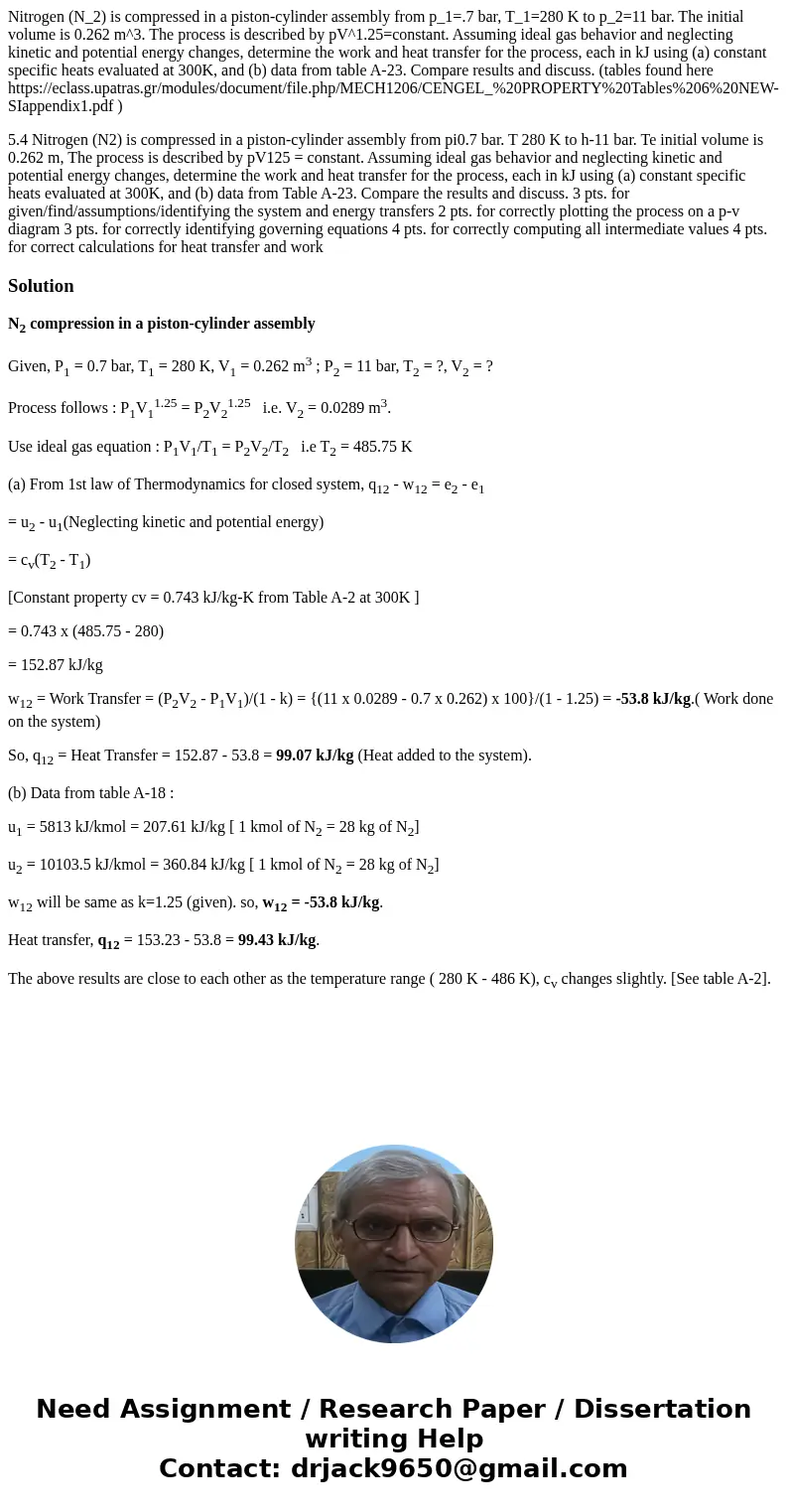Nitrogen N2 is compressed in a pistoncylinder assembly from
Nitrogen (N_2) is compressed in a piston-cylinder assembly from p_1=.7 bar, T_1=280 K to p_2=11 bar. The initial volume is 0.262 m^3. The process is described by pV^1.25=constant. Assuming ideal gas behavior and neglecting kinetic and potential energy changes, determine the work and heat transfer for the process, each in kJ using (a) constant specific heats evaluated at 300K, and (b) data from table A-23. Compare results and discuss. (tables found here https://eclass.upatras.gr/modules/document/file.php/MECH1206/CENGEL_%20PROPERTY%20Tables%206%20NEW-SIappendix1.pdf )
5.4 Nitrogen (N2) is compressed in a piston-cylinder assembly from pi0.7 bar. T 280 K to h-11 bar. Te initial volume is 0.262 m, The process is described by pV125 = constant. Assuming ideal gas behavior and neglecting kinetic and potential energy changes, determine the work and heat transfer for the process, each in kJ using (a) constant specific heats evaluated at 300K, and (b) data from Table A-23. Compare the results and discuss. 3 pts. for given/find/assumptions/identifying the system and energy transfers 2 pts. for correctly plotting the process on a p-v diagram 3 pts. for correctly identifying governing equations 4 pts. for correctly computing all intermediate values 4 pts. for correct calculations for heat transfer and workSolution
N2 compression in a piston-cylinder assembly
Given, P1 = 0.7 bar, T1 = 280 K, V1 = 0.262 m3 ; P2 = 11 bar, T2 = ?, V2 = ?
Process follows : P1V11.25 = P2V21.25 i.e. V2 = 0.0289 m3.
Use ideal gas equation : P1V1/T1 = P2V2/T2 i.e T2 = 485.75 K
(a) From 1st law of Thermodynamics for closed system, q12 - w12 = e2 - e1
= u2 - u1(Neglecting kinetic and potential energy)
= cv(T2 - T1)
[Constant property cv = 0.743 kJ/kg-K from Table A-2 at 300K ]
= 0.743 x (485.75 - 280)
= 152.87 kJ/kg
w12 = Work Transfer = (P2V2 - P1V1)/(1 - k) = {(11 x 0.0289 - 0.7 x 0.262) x 100}/(1 - 1.25) = -53.8 kJ/kg.( Work done on the system)
So, q12 = Heat Transfer = 152.87 - 53.8 = 99.07 kJ/kg (Heat added to the system).
(b) Data from table A-18 :
u1 = 5813 kJ/kmol = 207.61 kJ/kg [ 1 kmol of N2 = 28 kg of N2]
u2 = 10103.5 kJ/kmol = 360.84 kJ/kg [ 1 kmol of N2 = 28 kg of N2]
w12 will be same as k=1.25 (given). so, w12 = -53.8 kJ/kg.
Heat transfer, q12 = 153.23 - 53.8 = 99.43 kJ/kg.
The above results are close to each other as the temperature range ( 280 K - 486 K), cv changes slightly. [See table A-2].

 Homework Sourse
Homework Sourse